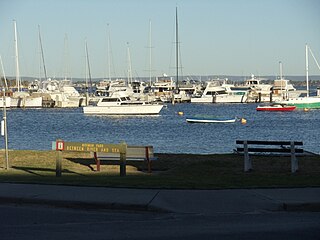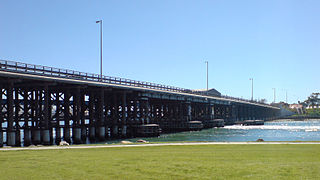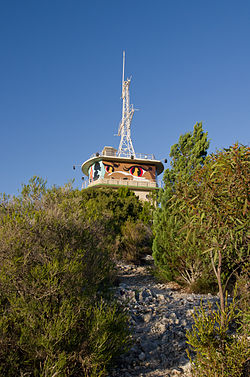
Fremantle is a port city in Western Australia, located at the mouth of the Swan River in the metropolitan area of Perth, the state capital. Fremantle Harbour serves as the port of Perth. The Western Australian vernacular diminutive for Fremantle is Freo.

Rottnest Island, often colloquially referred to as "Rotto", is a 19 km2 (7.3 sq mi) island off the coast of Western Australia, located 18 km (11 mi) west of Fremantle. A sandy, low-lying island formed on a base of aeolianite limestone, Rottnest is an A-class reserve, the highest level of protection afforded to public land.

Cottesloe is a western suburb of Perth, Western Australia, within the Town of Cottesloe. Cottesloe was named for Thomas Fremantle, 1st Baron Cottesloe, a prominent Tory politician and the brother of Admiral Sir Charles Fremantle for whom the city of Fremantle was named. The nearby suburb of Swanbourne was named for the Fremantle family seat, Swanbourne House, in Swanbourne, Buckinghamshire.
The Fremantle line is a suburban railway and service in Western Australia that connects the central business district (CBD) of Perth with Fremantle.

The Army Museum of Western Australia is a museum located in an historic artillery barracks on Burt Street in Fremantle, Western Australia. The museum was established in 1977 and has three Victoria Crosses on display.

Mosman Park is a western suburb of Perth, Western Australia on the north bank of the Swan River in the local government area of the Town of Mosman Park. It was historically known as Buckland Hill (1889–1909), then Cottesloe Beach (1909–1930) and again Buckland Hill (1930–1937). From 1937 it was named Mosman Park, derived from Mosman in Sydney, the birthplace of Richard Yeldon, a member of the Buckland Hill Road Board. Mosman Park is now considered an affluent suburb, but prior to the 1970s was one of Perth's major industrial centres.

Queen Victoria Street is the main road entering the city centre of Fremantle, Western Australia from the direction of Perth. The road was originally named Cantonment Road, but was subsequently renamed Victoria Road, and a few years later Queen Victoria Street, after Queen Victoria of the United Kingdom, to avoid confusion with similarly named roads in the area.

Challenger Harbour is a marina in Fremantle, Western Australia adjacent to the Fremantle Fishing Boat Harbour. The harbour breakwater covers the historical site of the Fremantle Long Jetty.

Fremantle Harbour is Western Australia's largest and busiest general cargo port and an important historical site. The inner harbour handles a large volume of sea containers, vehicle imports and livestock exports, cruise shipping and naval visits, and operates 24 hours a day. It is located adjacent to the city of Fremantle, in the Perth metropolitan region.

Completed in 1849, the original 20-metre (66 ft) Wadjemup Lighthouse was Western Australia's first stone lighthouse and was built to provide a safer sailing passage for ships to Fremantle Port and the Swan River Colony.

Rottnest Island lies 18 kilometres (11 mi) west of the coastline of Perth, Western Australia; it is 4.5 kilometres (2.8 mi) at its widest and 11 kilometres (6.8 mi) at its longest.

The Old Fremantle Police Station and Court House Complex is a heritage-listed group of buildings located at 45 Henderson Street, Fremantle, Western Australia. The complex includes the former courthouse, police station, police barracks and lock-up and artillery drill hall.

Walyalup Koort, formerly known as Kings Square (or King's Square), is a town square in Fremantle, Western Australia. It is bounded by Queen, Newman, William, and Adelaide Streets. Though the square was originally a public reserve, it has been the site of Saint John's Church of England since 1843, and the Fremantle Town Hall since 1887. High Street was extended through and beyond the square in the 1880s, but the portion through the square was closed off in the 1960s. Today Kings Square functions as a civic and cultural centre of Fremantle, with modern events taking place adjacent to the historic buildings.

Irwin Barracks is an Australian Army military base located in Karrakatta, a suburb of Perth, Western Australia. It occupies a 62-hectare (150-acre) site on the western side of the Fremantle railway line.

Burt Street is a street located in Fremantle, Western Australia. It runs between Queen Victoria Street and East Street and rises up the prominent hill that lies to the south of Cantonment Hill.
The Fremantle Volunteer Sea Rescue Group Inc, or Fremantle Sea Rescue (FSR), is a volunteer lead marine search and rescue service based in Fremantle, Western Australia. It operates continuously and responds to approximately 700 incidents a year. It is one of 39 sea rescue services recognised by the Department of Fire and Emergency Services, who between them cover over 13,000 kilometres (8,100 mi) of the Western Australian coast. Fremantle Sea Rescue was established in 1977. Prior to 1975 there was no formal sea rescue service operating in WA. Following an incident in 1972 when two people drowned after their boat hit a submerged object, at the insistence of East Fremantle Yacht Club, yacht clubs in the Perth area formed the Volunteer Sea Search and Rescue Association (WA) in 1975. It was from this organisation that the Fremantle Sea Rescue Service was formed.

Leighton Battery at Buckland Hill, Mosman Park, Western Australia, was part of the Coastal defences of Australia during World War II and the Fremantle Fortress, protecting Fremantle Harbour.

Fremantle Fortress was the combined coastal defences protecting the harbour of Fremantle, Western Australia, since the mid-1930s and, predominantly, during World War II. The coastal defences of the Fremantle Fortress stretched along the coastline of Perth from Cape Peron to Swanbourne and also included installations on Garden Island and Rottnest Island. While the first coastal batteries of the future Fremantle Fortress were installed at Arthur Head in 1906, the military installations protecting the harbour were expanded in the 1930s, being eventually dismantled again by 1963.

The Peron Battery, at Cape Peron, was the southernmost of the Fremantle Fortress coastal defence batteries in Western Australia. Also referred to as K Heavy Battery, it was established in January 1943 and, like the Challenger Battery on near-by Garden Island, it was equipped with two mobile 155mm guns. Additionally, it also operated two 18-pounder guns which were withdrawn once the Collie Secondary Battery became operational on Garden Island. The duty of the main guns was to cover the southern access to Cockburn Sound while the 18-pounder guns protected the a boom net which spanned between Cape Peron and Garden Island. The main battery was withdrawn again in December 1944 but the observation post and one of the Panama mounts of the Peron Battery are still preserved and accessible.

















